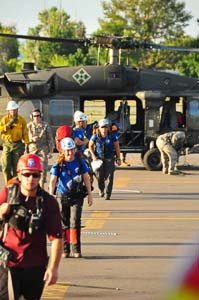Rocky Mountain Rescue recorded its second busiest year in its 67-year history, responding
to 162 calls, with 98 field responses. By call number, 2012 was our busiest year on record,
hinting that a sustained mission load of 160 may be the new normal, above the 15-year average
of 135.
Planning efforts for 2013 started in late 2012, preparing
for our MRA recertification test in May. We targeted and increased the training efforts to
ensure we performed well for the test. With a lot of effort by the entire team, and under the watchful
eyes of over 40 evaluators and observers from across Colorado and New Mexico,
RMRG successfully
passed the recertification and we continue to be a fully accredited MRA team.

Rescuers unloading from a National Guard helicopter after flood deployment Photo credit, Dave Zader
RMRGs biggest mission of the year occurred over 6 days starting on September 11th when
flash flooding ripped through the canyons and mountain towns of Boulder County. RMRG was
stretched beyond where many of us thought was possible with RMR members deployed into flood
zones by foot, 4WD and helicopter. We assessed access, rescued injured and stranded mountain
residents, and searched for the missing. RMRG also participated in the Incident Management
Team (IMT) which directed official flood response operations. Regional MRA teams also generously
contributed to the mountain search and rescue flood operations.
RMRG volunteered over 2,500 hours of time to the mission, assisted
by MRA teams which provided over 1,000 hours of mutual aid assistance. The
2013 Fall MRA Meridian PDF, 2 MB, 16 pp. has more on flood operations.
RMRG also continued to see rescues where, due to the fear of being charged, those in need delay
calls for help. In January, a party of three climbers became stuck
on the 3rd Flatiron and attempted self-rescue; an action RMRG fully supports. However as
the stuck climbers could not get themselves unstuck they delayed calling for help until dusk and as rain and snow
started to fall. They feared they would receive a bill for their rescue. On the 4th of
July, RMRG was called to rescue a man with a severe hip/leg injury sustained after falling
hiking. The cause of the fall was an injured ankle that had occurred further up the trail.
The man decided he did not want to pay for the rescue for an injured ankle, and so attempted
to hop down the trail. This led to a more serious fall. The delay in calling for help resulted
in rescuers entering the filed during the prime time for deteriorating mountain weather.
RMRG does not charge for rescue!
An additional mission of interest in 2013 occurred in late January. For the second time
in a few years RMRG was asked to track down a Personal Locator Beacon (PLB) transmitting a
distress signal. RMRG was notified by the Colorado Search
and Rescue Board (CSRB) of a PLB activation in East Boulder in commercial area of town.
The Air Force Rescue Coordination Center (AFRCC) was receiving regular signals of a PLB
activation and asked us to resolve the incident. Given the satellite reported PLB location,
it was unlikely that anyone activated the PLB seeking emergency assistance. Regardless RMRG
deployed teams and found the PLB using some non-standard direction finding techniques
(there was no 121.5MHz signal) in an electronics recycling business. PLBs are a great tool
for backcountry travellers and it has become apparent to RMRG that we will be using our
skills in resolving genuine emergencies in addition to accidental activations.
RMRG also continued its contribution to safety education within the climbing community,
providing a presentation at Neptune Mountaineering in March,
Learning from the Mistakes of Others: Causes of Climbing Accidents in Boulder, Colorado (video)
The presentation covers the causes of climbing accidents leading to rescues,
followed by a discussion on measures climbers can take before and after a climbing accident
occurs.
2013 Tabular Summary (PDF)
All years mission statistics, summaries & maps. (list)
|







 Rescuers unloading from a National Guard helicopter after flood deployment
Rescuers unloading from a National Guard helicopter after flood deployment